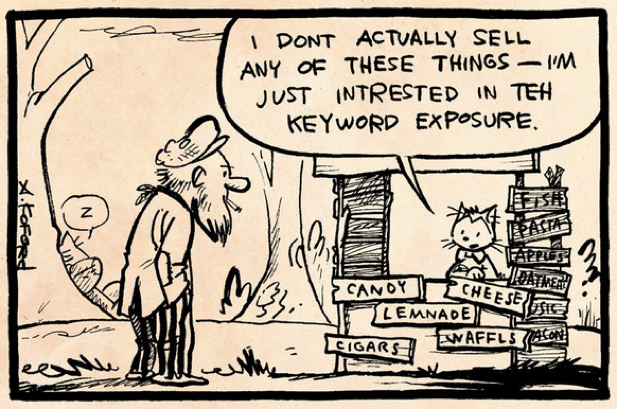
Let’s not waste any time – we know you’re busy. Here it is (in a nutshell):
Great… So, what’s a bucket brigade? We’ll tell you exactly what one is and how you can use it to increase dwell time and reduce bounce rates in a moment.
But first, let’s outline one of the greatest problems facing content marketers today.
It’s typical isn’t it? The very format that works best for content in terms of shares or rankings is also the one that goes completely against the grain of the impatient, scanning eye of the typical web visitor.
It’s been pretty thoroughly documented how well long-form content performs – but in the interests of fairness we should also mention in passing how viral silly pictures of cats can go.



So length is strength. It is links, ranking and shares. But only if a visitor sticks around. And the ‘natural’ skimming and scanning tendencies of web page visitors, so ably demonstrated by Jakob Nielsen, acts as a natural barrier to any long-form content’s success.

Look at where the eye goes here – it hugs the top and clings to the side like a person trying to survive a hurricane. And then, in a blast of wind, it’s gone. We’ve looked more closely at what Nielsen has to tell us about writing for the web in a recent post on grammar – take a look (but don’t forget to come back).
We’re about to reveal a killer tactic for serving the scan and delivering the dwell. There are no bounces on us. And here’s why…
A quick quiz. Is a bucket brigade:
A. A local community environmental action group that uses an air monitoring device (the bucket) to campaign against pollution.
B. A line of people used by firemen to pass buckets of water from a distant tap to a fire.
C. A form of analogue delay used by guitarists where parcels of sound are lost like drops of water from the buckets in item B.
D. A technique used by copywriters to maintain a reader’s interest.
E. A cyber-attack in which messages are intercepted in a public key exchange and then retransmitted with a substituted public key for the requested one.
F. The regulars at a pub who have their own beer ‘buckets’ behind the bar.
Surprisingly, it is all of these things – but there are no prizes for guessing which one we’re going to be looking at. And we’ll let Brian Dean (aka Backlinko) pass the first bucket. In his brilliant ‘16 powerful SEO copywriting secrets’ Dean introduces bucket brigades as something that will “slash your bounce rate and boost your time on page” metrics. Sounds good, eh?
Bucket brigades are words and phrases that keep people on your page. And, while Dean uses them to boost his SEO through metrics like dwell time, they go back to way before Google was even a twinkle in the eyes of Larry Page and Sergey Brin. The bucket brigade is an old-school copywriting tactic that was originally designed to keep people reading sales letters.
And the best part is, it’s not just an SEO tactic. Giselle Navarro, Head of Outreach at Neomam Studios, recommends using them in email outreach copy.
Wherever you need to carry over someone’s interest, like the old firemen needed to transport water from one place to another, you need to call on the bucket brigade. So ring those bells and form an orderly line. Here’s how it works:

Here they are used at the start of an article to hook the reader. They promise to deliver a secret and, once this is done, they’re used to keep up the momentum and the interest. And here’s the really clever thing: the second bucket brigade is answered by a question that acts just like a bucket brigade!
Look:
But you’re probably wondering: [wondering what? – tell me more]
How do I find SEO strategies that actually work?: [I was – I’ll read on as I still need to find out!]
Bucket brigades are great at the start of an article, but they’re at their most effective later on. In fact, if you want to know when to use, them just write your article without them. Now reread it and think:
You’ll find plenty of examples throughout this post, but here’s a list of common phrases you can use if inspiration runs dry.
So now you’ve got that wrapped, go out and drop them. The only thing that’s worse than a ‘bad’ long-form content post is a potentially great one that just doesn’t get read. It’s a crying shame: don’t let it happen to yours.
Because here’s what Google fails to ever mention: You can serve search intent all day long but, when the interest wanes, the eye wanders and the arrow starts its inevitable journey to the back bar on your browser…

You need to call on the bucket brigade.

It’s okay – the fire’s out!











